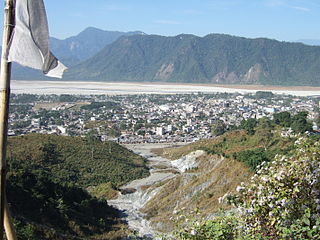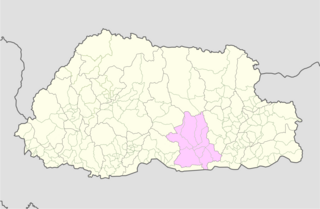
Chukha District is one of the 20 dzongkhag (districts) comprising Bhutan. The major town is Phuentsholing which is the gateway city along the sole road which connects India to western Bhutan. Chukha is the commercial and the financial capital of Bhutan. With Bhutan's oldest hydropower plant, Chukha hydel, and Tala Hydroelectricity Project, the country's largest power plant, Chukha is the dzongkhag which contributes the most to the GDP of the country. Also located in Chukha district are some of the country's oldest industrial companies like the Bhutan Carbide Chemical Limited (BCCL) and the Bhutan Boards Products Limited (BBPL).

Mongar District is one of the 20 dzongkhags (districts) comprising Bhutan. Mongar is the fastest-developing dzongkhag in eastern Bhutan. A regional hospital has been constructed and the region is bustling with many economic activities. Mongar is noted for its lemon grass, a plant that can be used to produce an essential oil. It also has a hydroelectric power-plant on the Kuri Chhu river.

Samtse District is one of the 20 dzongkhags (districts) comprising Bhutan.

A gewog, in the past also spelled as geog, refers to a group of villages in Bhutan. The head of a gewog is called a gup. Gewogs form a geographic administrative unit below dzongkhag districts, and above Dzongkhag Thromde class B and Yenlag Thromde municipalities. Dzongkhag Thromde class A municipalities have their own independent local government body.

Phuntsholing, also spelled as Phuentsholing, is a border town in southern Bhutan and is the administrative seat of Chukha District. The town occupies parts of both Phuentsholing Gewog and Sampheling Gewog.

Getena Gewog is a gewog of Chukha District, Bhutan. The gewog has an area of 214 square kilometres. It contains 7 villages and 118 households.

Bjacho Gewog, also spelled Bjagchhog, is a gewog of Chukha District, Bhutan. The gewog has an area of 140 square kilometres and contains 4 villages; Bjachho, Tsimakha, Mebesa and Wangkha.

Bongo Gewog is a gewog of Chukha District, Bhutan. The gewog is the largest in the district with an area of 396 square kilometres. It contains 15 villages.

Chapcha Gewog is a gewog of Chukha District, Bhutan. It has an area of 112.6 square kilometres and contains 11 villages.

Dala Gewog is a gewog of Chukha District, Bhutan. The gewog has an area of 139.7 square kilometres and contains 7 villages. Dala Gewog is part of Phuentsholing Dungkhag, along with Logchina and Phuentsholing gewogs.

Geling Gewog is a gewog of Chukha District, Bhutan. The gewog has an area of 247 square kilometres and contains 11 villages.

Logchina Gewog is a gewog of Chukha District, Bhutan. The gewog has an area of 70.4 square kilometres and contains 12 villages. Logchina Gewog is part of Phuentsholing Dungkhag (sub-district), along with Dala, Sampheling, Dungna, Metakha and Phuentsholing Gewogs.

Metakha Gewog is a gewog of Chukha District, Bhutan. The gewog has an area of 100 square kilometres and contains six villages.

Phuentsholing Gewog is a gewog of Chukha District, Bhutan. The gewog has an area of 139.8 square kilometres and contains 19 villages. Phuentsholing Gewog is part of Phuentsholing Dungkhag, along with Dala, Logchina Gewogs and Shampheling Gewog. It is one of the highest populated gewog in Chukha Dzongkhag.

Katsho Gewog is a gewog of Haa District, Bhutan. Before substantial border changes, the gewog in 2007 had an area of 42.3 square kilometres and contained 10 villages and 247 households.

Hungrel Gewog is a gewog of Paro District, Bhutan. In 2002, the gewog had an area of 3.6 square kilometres and contained 17 villages and 247 households.

Lungnyi Gewog is a gewog of Paro District, Bhutan. In 2002, the gewog had an area of 59.7 square kilometres and contained seven villages and 265 households.
Biru Gewog is a former gewog of Samtse District, Bhutan. The gewog has an area of 49.04 square kilometres and contains 15 chewogs with 46 villages and 448 households. Biru Gewog comprises part of Sipsu Dungkhag (sub-district), together with Tendu, Bara, Lehereni, and Sipsu Gewogs.

Goshing Gewog is a gewog of Zhemgang District, Bhutan. Goshing Gewog is also a part of Panbang Dungkhag (sub-district), along with Bjoka, Ngangla, and Phangkhar Gewogs.

Chali Gewog is a gewog of Mongar District, Bhutan. In 2002, the gewog contained 263 households and covered an area of 42 square kilometres.









